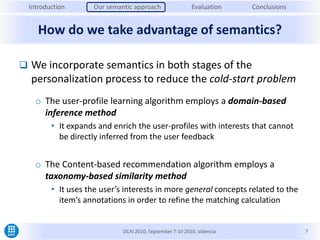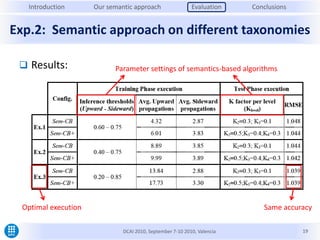Presentacion Dcai 2010
- 1. A Recommendation System for the Semantic Web Victor Codina and Luigi Ceccaroni vcodina@lsi.upc.edu Departament de Llenguatges i Sistemes Informàtics (LSI) Universitat Politècnica de Catalunya (UPC) DCAI 2010, September 7-10 2010, Valencia
- 2. Introduction Our semantic approach Evaluation Conclusions Outline  Introduction & motivations  Our semantic approach  Evaluation  Conclusions & future work DCAI 2010, September 7-10 2010, Valencia 2
- 3. Introduction Our semantic approach Evaluation Conclusions The general personalization process ITEMS CONTENT ADAPTATION Item Representation USER MODELING Recommendation strategy Implicit feedback Learning User Profile algorithm Personalized Explicit Recommendation feedback User satisfaction User behavior USERS DCAI 2010, September 7-10 2010, Valencia 3
- 4. Introduction Our semantic approach Evaluation Conclusions Potential benefits of using semantics  The use of semantics provides several advantages to reduce some limitations of current recommenders o Cold-start problem • By inferring missing information exploiting the relationships of domain ontologies o Domain-dependency • By employing standard ontology-based languages to uniformly represent information DCAI 2010, September 7-10 2010, Valencia 4
- 5. Introduction Our semantic approach Evaluation Conclusions Service oriented architecture design DCAI 2010, September 7-10 2010, Valencia 5
- 6. Introduction Our semantic approach Evaluation Conclusions User’s interests and Item representation  Ontology-based representation (weighted overlay) Weighted User’s interest Concept taxonomies Weighted Item annotation DCAI 2010, September 7-10 2010, Valencia 6
- 7. Introduction Our semantic approach Evaluation Conclusions How do we take advantage of semantics?  We incorporate semantics in both stages of the personalization process to reduce the cold-start problem o The user-profile learning algorithm employs a domain-based inference method • It expands and enrich the user-profiles with interests that cannot be directly inferred from the user feedback o The Content-based recommendation algorithm employs a taxonomy-based similarity method • It uses the user’s interests in more general concepts related to the item’s annotations in order to refine the matching calculation DCAI 2010, September 7-10 2010, Valencia 7
- 8. Introduction Our semantic approach Evaluation Conclusions Semantically-enhanced learning algorithm START. The user provides some feedback about an item (e.g. a purchase or rating of an item) User Step 1. Interest weights of the concepts related to the item are calculated/updated Inferred Learnt Step 2. A domain-based inference method Updated infers new interests from the families of concepts with updated interests Item DCAI 2010, September 7-10 2010, Valencia 8
- 9. Introduction Our semantic approach Evaluation Conclusions The domain-based inference method  Based on the minimum percentage of direct subconcepts  Two types of propagation o Upward-based (propagation to the parent concept) o Sideward-based (propagation to the siblings) Upward-based? Sport Pct(subconcepts) = 4/5 = 0.8 [0.5] Sideward-based? 0.8 > UIT = 0.6 => Propagation Pct(subconcepts) = 4/5 = 0.8 0.8 > SIT = 0.9 => No propagation Baseball Basketball Football Tennis Golf [-0.5] [0.5] [1.0] [1.0] [?] Upward-based threshold (UIT) = 0.6 Sideward-based threshold (SIT) = 0.9 DCAI 2010, September 7-10 2010, Valencia 9
- 10. Introduction Our semantic approach Evaluation Conclusions Semantically-enhanced content-based filtering START. The system has to predict if the user will like/dislike an item User FOR EACH item’s annotation DO: STEP 1. The conceptScore is calculated based on: Partial • The interest degree of the user’s interests that Partial match the item’s annotation • The semantic similarity of the matchings C2 (perfect or partial match) C1 Perfect END FOR Item STEP 2. The itemScore is calculated using the weighted average of conceptScore values according to their relevance DCAI 2010, September 7-10 2010, Valencia 10
- 11. Introduction Our semantic approach Evaluation Conclusions The taxonomy-based similarity method  Based on the distance in terms of taxonomy levels between o The item’s annotation o The user’s interest (an ancestor of the item’s annotation)  Weighted semantic distance among levels using K factor Level 1 Source Genre User Level 2 Sport Romance Interest distance = 1 User Item Level 3 Extreme Annotation Steamy Romance K3 = 0.4 Interest distance = 1 Item SIM = 0.6 Level 4 Climbing K4 = 0.3 Annotation SIM = 0.7 DCAI 2010, September 7-10 2010, Valencia 11
- 12. Introduction Our semantic approach Evaluation Conclusions Experimental dataset  Netflix-prize movie dataset o 480,000 users o 17,700 movies o 100M user ratings ranging between 1 and 5  Movie taxonomy used by Netflix for annotating movies o 1 global hierarchy of concepts describing the movies o 3 levels of depth o 550 nodes (item’s annotations)  RMSE metric o Measures the error on rating prediction for a set of users DCAI 2010, September 7-10 2010, Valencia 12
- 13. Introduction Our semantic approach Evaluation Conclusions Experimental evaluation  Exp. 1: Traditional vs semantic approach o GOAL. To evaluate the improvement on accuracy when the semantics-based methods are employed • Is cold-start problem reduced?  Exp. 2: Semantic approach on two different taxonomies o GOAL. To analyze if the hierarchical structure of the taxonomy affect the effectiveness of semantics-based methods • How the taxonomy structure affect their performance? DCAI 2010, September 7-10 2010, Valencia 13
- 14. Introduction Our semantic approach Evaluation Conclusions Exp.1: Traditional vs Semantic approach  Experiment setup o The error of two algorithm configurations is compared • CB configuration (traditional CB approach) • SEM-CB configuration (semantically-enhanced CB approach) User profile Interest-prediction Config. Item - User matching representation method Keyword-based CB Rating-based Perfect matches profile Rating-based Perfect + Partial Ontology-based SEM-CB + matches profile Domain inference (semantic similarity) DCAI 2010, September 7-10 2010, Valencia 14
- 15. Introduction Our semantic approach Evaluation Conclusions Exp.1: Traditional vs Semantic approach  Overall prediction results: 1,065 1,06 1,055 1,05 1,045 RMSE 1,04 1,035 1,03 1,025 CB SEM-CB DCAI 2010, September 7-10 2010, Valencia 15
- 16. Introduction Our semantic approach Evaluation Conclusions Exp.1: Traditional vs Semantic approach  Prediction results grouped by user-profile size (nº ratings) Each interval nearly contains 2% of predictions of the Netflix test-set DCAI 2010, September 7-10 2010, Valencia 16
- 17. Introduction Our semantic approach Evaluation Conclusions Exp.1: Traditional vs Semantic approach  Comparison of RMSE based on user-profile size The improvement is bigger in users with small profile-size (the cold-start users) DCAI 2010, September 7-10 2010, Valencia 17
- 18. Introduction Our semantic approach Evaluation Conclusions Exp.2: Semantic approach on different taxonomies  Experiment setup o Two semantics-based configurations are compared on different versions of the movie taxonomy: • Sem-CB configuration (employs the original taxonomy) • Sem-CB+ configuration (employs an alternative version) Taxonomy properties Avg. Size of nodes Config. Nº nodes Nº levels Nº hierarchies per family SEM-CB 550 3 1 14 SEM-CB+ 550 4 4 7 DCAI 2010, September 7-10 2010, Valencia 18
- 19. Introduction Our semantic approach Evaluation Conclusions Exp.2: Semantic approach on different taxonomies  Results: Parameter settings of semantics-based algorithms Optimal execution Same accuracy DCAI 2010, September 7-10 2010, Valencia 19
- 20. Introduction Our semantic approach Evaluation Conclusions Conclusions and Future work  Main conclusions o The cold-start problem is reduced by exploiting semantics o The incorporation of semantics in a traditional CB approach o The recommender is domain-independent by combining • A service oriented architecture design • Standard ontology-based languages (FOAF, OWL)  Future work o Further experimentation • In richer domains and with other semantic methods o The incorporation of semantics into other approaches • e.g. Collaborative Filtering and Hybrid systems DCAI 2010, September 7-10 2010, Valencia 20
- 21. A Recommendation System for the Semantic Web Victor Codina and Luigi Ceccaroni vcodina@lsi.upc.edu Departament de Llenguatges i Sistemes Informàtics (LSI) Universitat Politècnica de Catalunya (UPC) DCAI 2010, September 7-10 2010, Valencia
- 22. Introduction Our semantic approach Evaluation Conclusions Exp.1: Traditional vs Semantically-enhanced  Comparison of overall accuracy results: 1,08 1,06 1,04 1,02 1 0,98 0,96 0,94 RMSE 0,92 0,9 0,88 DCAI 2010, September 7-10 2010, Valencia 22









![Introduction Our semantic approach Evaluation Conclusions
The domain-based inference method
 Based on the minimum percentage of direct subconcepts
 Two types of propagation
o Upward-based (propagation to the parent concept)
o Sideward-based (propagation to the siblings)
Upward-based? Sport
Pct(subconcepts) = 4/5 = 0.8 [0.5] Sideward-based?
0.8 > UIT = 0.6 => Propagation Pct(subconcepts) = 4/5 = 0.8
0.8 > SIT = 0.9 => No propagation
Baseball Basketball Football Tennis Golf
[-0.5] [0.5] [1.0] [1.0] [?]
Upward-based threshold (UIT) = 0.6
Sideward-based threshold (SIT) = 0.9
DCAI 2010, September 7-10 2010, Valencia 9](https://image.slidesharecdn.com/presentaciondcai2010-12840293236148-phpapp02/85/Presentacion-Dcai-2010-9-320.jpg)












